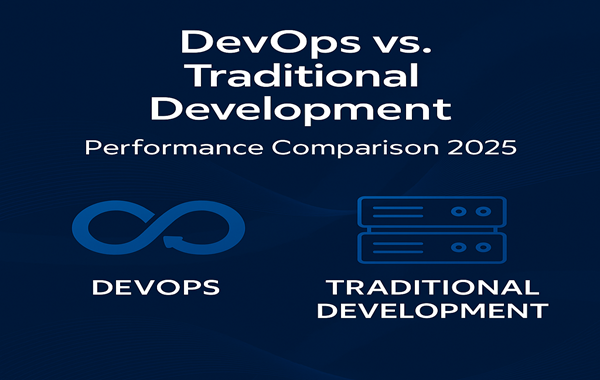DevOps vs. Traditional Development: Performance Comparison 2025
In the rapidly changing world of software development, organizations are constantly seeking methods to enhance efficiency, speed, and collaboration. Two primary methodologies have emerged as frontrunners: the traditional software development model and the DevOps approach. While both aim to deliver high-quality software, they differ significantly in their processes, team dynamics, and overall effectiveness. This article explores the key differences between these two methodologies, providing insights into their respective strengths and weaknesses.
Understanding Traditional Software Development
The Waterfall Model
Traditional software development often adheres to the Waterfall model, a linear and sequential approach. This methodology consists of distinct phases: requirements gathering, design, development, testing, deployment, and maintenance. Each phase must be completed before moving on to the next, which can lead to significant delays and challenges in adapting to changing requirements.
Characteristics of Traditional Development
-
Siloed Teams: Development, testing, and operations teams typically work in isolation, leading to communication gaps.
-
Manual Processes: Many tasks are performed manually, increasing the likelihood of errors and inefficiencies.
-
Long Development Cycles: The sequential nature of the Waterfall model often results in extended timelines for project completion.
Pros and Cons
Benefits:
-
Predictability: The structured approach allows for clear timelines and deliverables.
-
Defined Roles: Each team member has specific responsibilities, which can simplify project management.
Drawbacks:
-
Inflexibility: Adapting to changes late in the process can be costly and disruptive.
-
Delayed Feedback: Feedback is often received only after deployment, making it difficult to implement improvements quickly.
The Rise of DevOps
A Cultural Shift
DevOps represents a cultural and operational shift that emphasizes collaboration between development and operations teams. This methodology aims to automate and streamline the software delivery process, fostering a more agile and responsive environment.
Key Characteristics of DevOps
-
Integrated Teams: Development and operations work together, sharing responsibilities and fostering continuous communication.
-
Automation: Many processes, including testing and deployment, are automated to reduce errors and speed up delivery.
-
Continuous Integration and Delivery (CI/CD): Code changes are integrated frequently, allowing for rapid deployment of new features.
Advantages and Challenges
Benefits:
-
Faster Time-to-Market: The emphasis on automation and collaboration allows for quicker releases.
-
Improved Quality: Continuous testing and integration lead to higher-quality software with fewer defects.
Challenges:
-
Cultural Resistance: Transitioning to a DevOps model can face pushback from teams accustomed to traditional methods.
-
Initial Investment: Implementing DevOps practices may require significant upfront investment in tools and training.
Comparing Development Approaches
Team Dynamics
In traditional development, teams operate in silos, which can lead to miscommunication and delays. In contrast, DevOps promotes a culture of collaboration, where teams work together towards common goals. This integration fosters a sense of shared ownership and accountability, resulting in faster problem resolution and improved project outcomes.
Development Cycles
The Waterfall model's sequential phases can lead to long development cycles, making it challenging to respond to market changes. DevOps, on the other hand, emphasizes continuous delivery, allowing teams to release smaller, incremental updates. This agility enables organizations to adapt quickly to customer feedback and changing market conditions.
Automation vs. Manual Processes
Traditional development relies heavily on manual processes, which can be time-consuming and error-prone. DevOps leverages automation to streamline tasks such as testing and deployment, reducing the risk of human error and accelerating the overall development process.
Incident Management
In traditional models, incident management is often reactive, addressing issues only after they arise. DevOps encourages proactive monitoring and quick responses to incidents, allowing teams to identify potential problems before they escalate. This shift in mindset fosters a culture of continuous improvement and collaboration.
Performance Metrics: A Closer Look
Speed and Efficiency
One of the most significant advantages of DevOps is its ability to deliver software faster and more efficiently. According to industry studies, organizations that adopt DevOps practices can achieve deployment frequencies that are 30 times higher than those using traditional methods. This increased speed allows businesses to stay competitive in a fast-paced market.
Quality Assurance
Quality is another critical metric in software development. DevOps practices, such as continuous testing and integration, lead to fewer defects and higher-quality software. Research indicates that organizations implementing DevOps experience a 50% reduction in failure rates compared to traditional development approaches.
Customer Satisfaction
Ultimately, the goal of any software development methodology is to meet customer needs. DevOps enables organizations to respond quickly to customer feedback, resulting in improved satisfaction levels. By delivering features and updates more rapidly, businesses can better align their products with customer expectations.
Best Practices for DevOps Implementation
Establishing a Collaborative Culture
To successfully implement DevOps, organizations must foster a culture of collaboration and shared responsibility. This involves breaking down silos between teams and encouraging open communication. Regular meetings and collaborative tools can help facilitate this cultural shift.
Automating Processes
Investing in automation tools is crucial for streamlining development and deployment processes. By automating repetitive tasks, teams can focus on higher-value activities, such as innovation and problem-solving. A well-structured CI/CD pipeline setup guide can help organizations effectively implement automation.
Continuous Learning and Improvement
DevOps is not a one-time implementation but an ongoing journey. Organizations should prioritize continuous learning and improvement by regularly assessing their processes and seeking feedback from team members. This commitment to growth will help maintain a competitive edge in the ever-evolving software landscape.
Conclusion
The choice between traditional software development and DevOps is not merely a matter of preference; it significantly impacts an organization's ability to deliver high-quality software efficiently. While traditional methods may still be suitable for specific projects with stable requirements, the advantages of DevOps—speed, quality, and adaptability—make it the preferred choice for modern software development.
By understanding the fundamental differences between these two approaches, organizations can make informed decisions about how to structure their software development processes. Embracing DevOps practices can lead to improved collaboration, faster delivery, and ultimately, greater customer satisfaction. As we move into 2025 and beyond, the importance of adopting agile methodologies like DevOps will only continue to grow in the competitive landscape of software development.
This article provides a comprehensive overview of the differences between traditional software development and DevOps, highlighting the benefits and challenges of each approach. By focusing on key performance metrics and best practices for implementation, organizations can better navigate their software development journeys.







